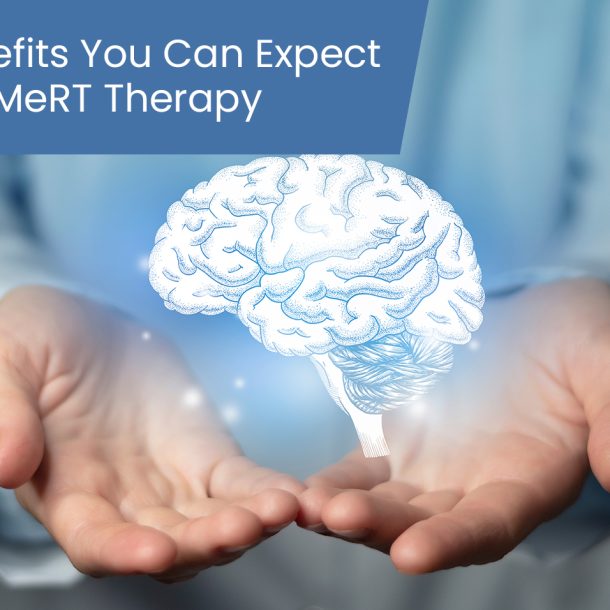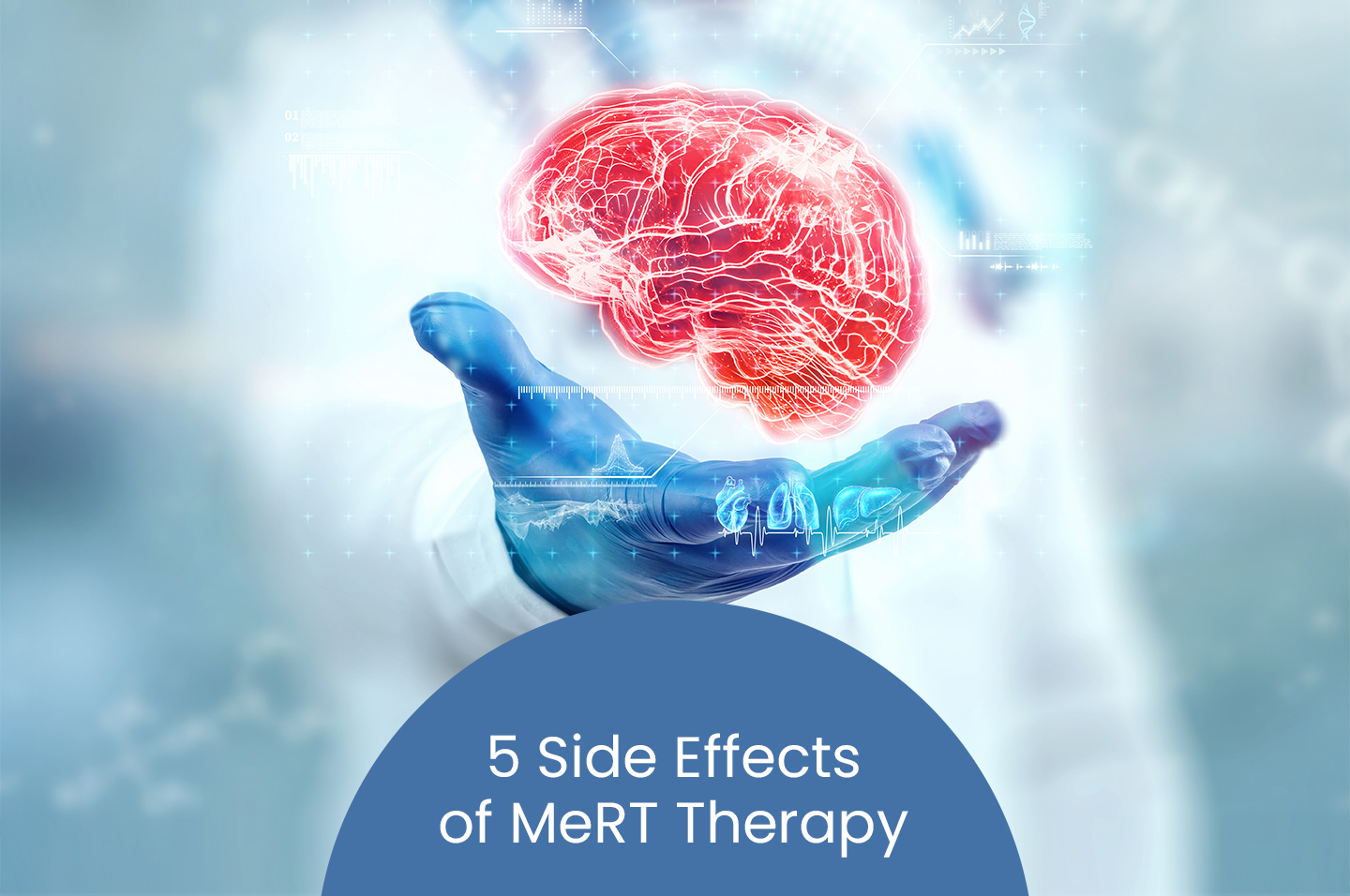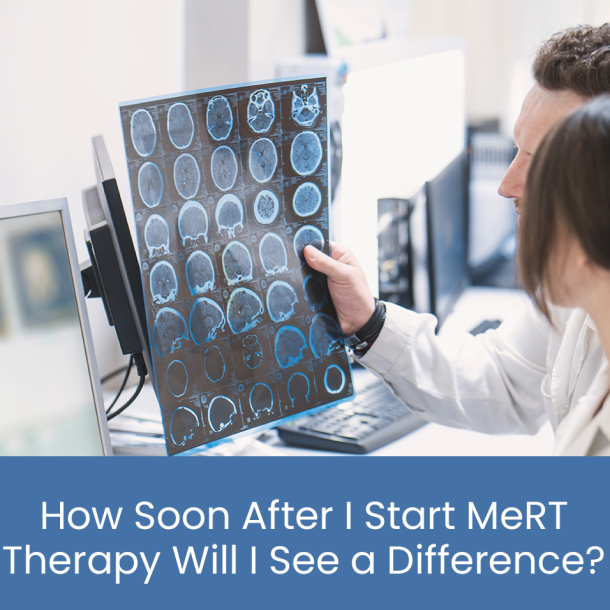
5 Side Effects of MeRT Therapy
- Home /
- 5 Side Effects of MeRT Therapy

As with any treatment form, patients seek to educate themselves further on not just what the therapy offers and how it benefits them, but also on MeRT therapy’s side effects.
This in-depth knowledge-seeking provides a more balanced perspective on therapy and allows people to make a well-informed decision about whether it is for them.
What is MeRT therapy?
In discussing MeRT’s side effects, we must first define the therapy. MeRT (Magnetic Resonance Therapy) incorporates customized use of Transcranial Magnetic Stimulation (TMS).
Healthcare professionals use a system of sophisticated diagnostics (EEG or qEEG) to determine which brain areas require remapping in order to alleviate the symptoms from a range of neurological conditions.
MeRT is painless, non-invasive, and drug-free. Diagnostics search for patterns of brain dysfunction, which act as identifiers for various disorders like behavioural and learning issues, brain injury, emotional and mental disorders, and more. EEGs provide a map that guides the patient’s treatment.
The equipment incorporated for treatment is FDA-cleared and generates magnetic waves that gently stimulate targeted brain areas. MeRT protocols have witnessed success in improving post-traumatic stress disorder, autism spectrum disorder, concussions, traumatic brain injuries, depression, sleep disorders, and anxiety.
At Neurosync Brain Treatment Centre, we combine machine learning analysis with our vast expertise in neuroscience to classify and decode brain indicators, which we can change using individualized treatment options.
What are the side-effects of MeRT?
Overall, current data suggests that the side effects of MeRT therapy, if any, are mild and easily manageable, providing a sense of comfort and ease to the patients. Reported side effects include the following:
1. Headaches
Mild tension headaches are the most commonly reported side effects. They occur at the stimulation site and may last one to two hours. Headaches associated with MeRT therapy respond to over-the-counter analgesics and tend to diminish with subsequent sessions.
2. Hyperactivity
While MeRT uses electromagnets to stimulate the brain with repeated low-intensity impulses, there is a slight risk of hyperactivity. Since it works by stimulating neural brain circuits and neurons, over-stimulation is possible, which can result in hyperactive behaviour.
However, low impulses are generally not high enough to generate a significant response. The existence of this side effect isn’t fully understood yet.
3. Increased agitation
Some clients may experience increased agitation in response to the brain being overstimulated. The brain’s primary function is to gather and process sensory information.
However, when it receives too much sensory input, the brain thinks it is in danger and signals that the body should escape. This overstimulation makes individuals feel irritable, overwhelmed, and uncomfortable.
4. Euphoria
When certain brain areas receive stimulation, it can trigger euphoric sensations. However, for MeRT therapy, there is a low chance of this occurring since higher amounts of stimulation generally trigger euphoria.
The nucleus accumbens is an area known to regulate pleasure, reward, and addiction. When overstimulated, or if overstimulation in this area pre-exists, euphoric sensations are possible.
5. Seizure
While the risk of seizures is rare (1 in 100,000), they can occur as a byproduct of brain stimulation. To reduce the risk of seizures, we limit the stimulation intensity.
Again, side effects from MeRT are mild and rare, and further investigation is still underway as to exactly what causes these side effects in some patients. It can be speculated that they can arise because some pre-existing conditions cause the client’s brain to be overstimulated in the first place, or that mapping produces these effects in the brain.
While this is plausible, it is more the exception than the norm. Patients respond differently to treatment, which can generate these types of responses. However, current research states you would require a higher impulse frequency to elicit such behavioural and physiological responses commonly.
This makes MeRT a better-tolerated form of therapy because of the low-frequency impulses it emits compared to other methods of treatment. This also indicates a low expectancy of side effects, with milder forms when they do occur.
What can I do to receive better results?
Consistency is essential with any type of brain mapping. The more repetition the brain receives, the greater the possibility of adopting the activity. Behaviours and routines outside of receiving treatment are just as crucial. Modifying them will mimic what the brain under MeRT instructs it to do. Thus, many professionals combine MeRT with other therapy forms.
Behaviours That Benefit You
- Sleep: A relaxing, restful sleep between 10:00 p.m. and 2:00 a.m. is essential for the brain to recover from MeRT therapy sessions.
- Morning sunlight: Clients benefit from at least 30 minutes of sunlight (generally, between 7:00 a.m. and 11:00 a.m.) daily, which produces healthy hormones and supports the new waves.
- Blue light: Incorporating blue light assists the body in becoming more awake as it naturally recognizes sleep and wake patterns.
Harmful Behaviours
- Screen time: Just as the blue light from devices can help you become more awake during the day, they are detrimental at night. During the evening, it is essential to limit screen time as it confuses the brain’s circadian rhythm. It fights the work accomplished by MeRT. If you must use your devices, computer, or anything else that emits blue light, you can also incorporate a filter to decrease its effects on the brain.
- Substance usage: Marijuana/THC and alcohol interfere with the results from MeRT. Adopting a sober lifestyle helps you benefit from what you receive from this therapy.
We recommend that clients choose a healthy routine when receiving treatment. This improves long-term results and prepares them for a lifestyle that supports those results. If you experience relief from MeRT therapy and feel better, continue doing things that encourage healthy brain wave activity for the remainder of your life.
Why choose Neurosync Brain Treatment Centre?
While MeRT therapy side effects are mild and well-tolerated, they do exist in a small percentage of the population. More research into these side effects, why they occur, and the long-term ramifications of MeRT therapy still must be conducted.
At Neurosync Brain Treatment Centre, we use technology that empowers people to understand their brains and overcome physical and mental health barriers without invasive procedures or pharmaceuticals. Our organization combines decades of research with a focused methodology to generate broader access to healthcare.
To book a consultation with one of our specialists, contact us at 365-799-8438. You can also email us at neurosyncbtc@outlook.com or fill out our online form.
Working Hours
Email: neurosyncbtc@outlook.com
Woodbridge. ON. L4L 1A6

